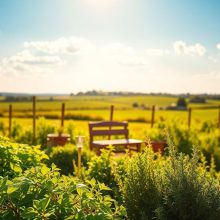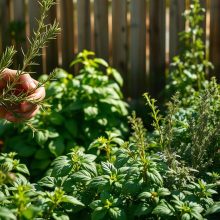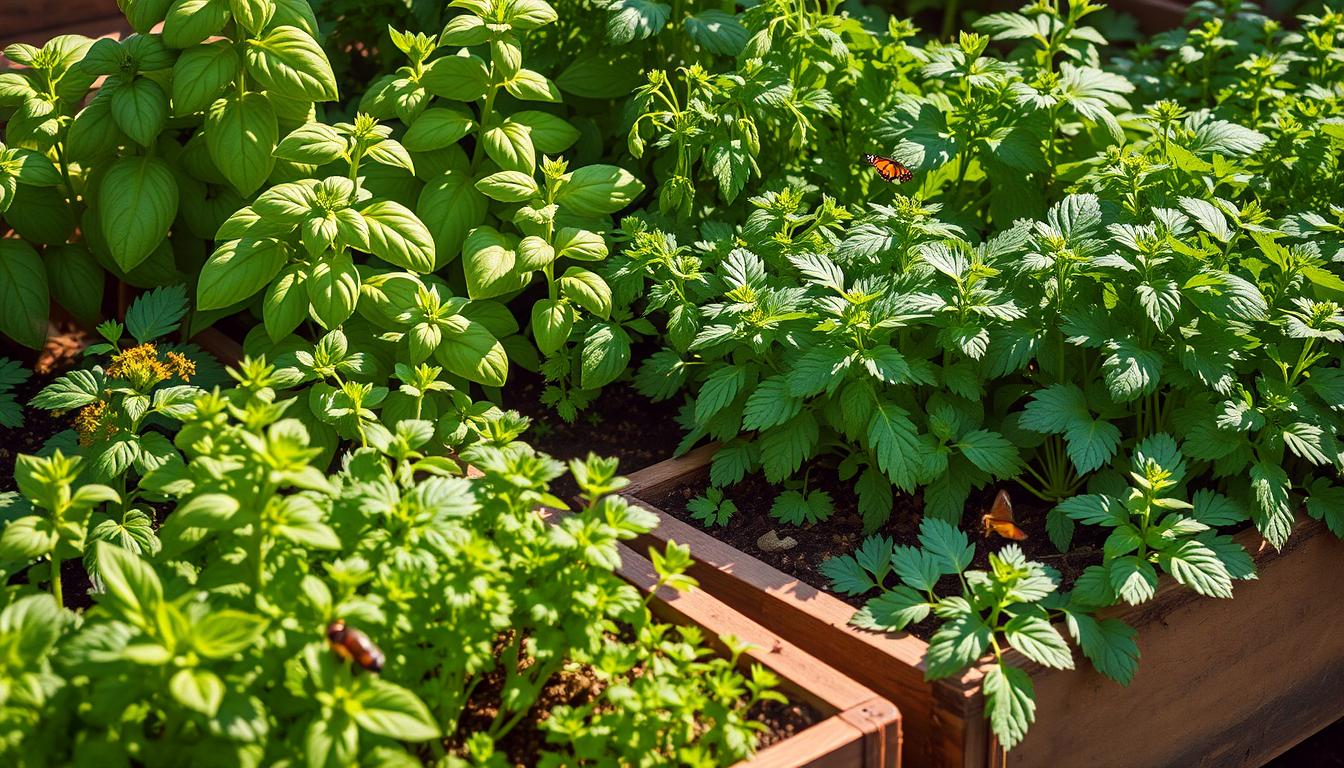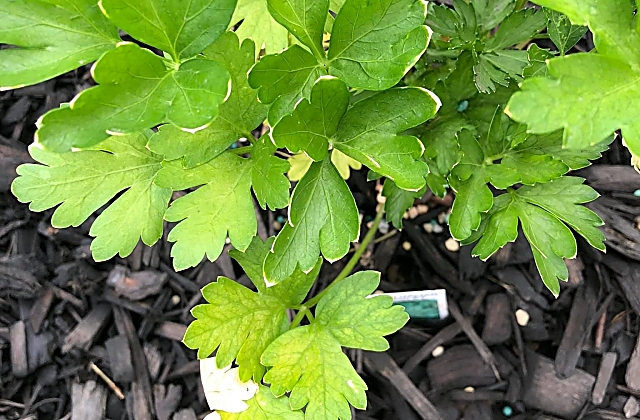Seasonal Herb Planting: A Guide for Beginners
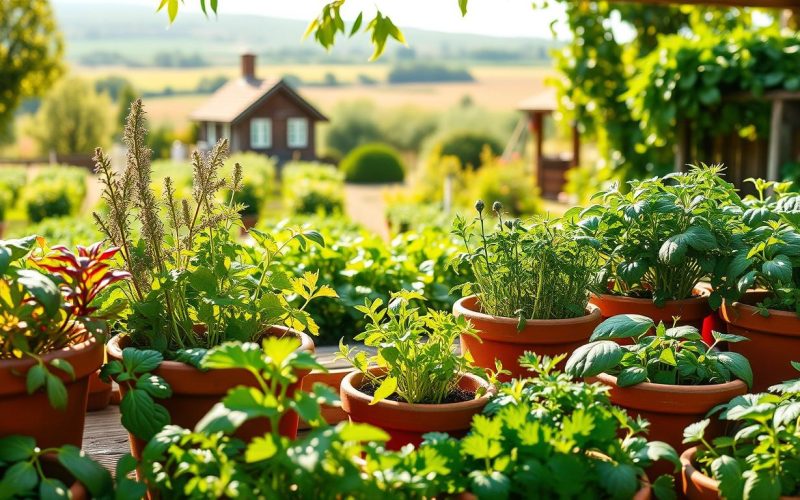
Exploring seasonal herb planting opens a world of fresh tastes and lively gardens. It lets home gardeners boost their cooking skills and make stunning green areas. A detailed guide to seasonal herb gardening teaches beginners how to grow herbs all year round.
Herbs are a wide range of plants with amazing uses. From rosemary’s woody stems to cilantro’s tender leaves, each type has special traits. By learning what each plant needs, gardeners can turn any space into a lush herb garden.
Seasonal herb planting is more than just gardening. It’s about making spaces that are green, tasty, and fragrant. This guide will show beginners the key techniques, seasonal tips, and ways to grow herbs well.
Key Takeaways
- Learn the basics of seasonal herb planting techniques
- Understand different herb varieties and their growth patterns
- Discover how to create optimal growing conditions
- Explore culinary and medicinal uses of various herbs
- Develop skills for sustainable herb gardening practices
Understanding Seasonal Herbs
Herb gardening is a fun way to improve your cooking and connect with nature. Seasonal herbs grow best at certain times of the year. Knowing when to plant them can make gardening more rewarding.
Gardeners choose the best herbs for each season. These herbs grow well in specific times and conditions. This leads to strong and tasty plants.
What Are Seasonal Herbs?
Seasonal herbs grow best at certain times of the year. They match the climate perfectly:
- Spring herbs like cool weather
- Summer herbs love the heat
- Fall herbs handle early frost well
- Winter herbs survive cold
Benefits of Planting Seasonal Herbs
Choosing the right herbs for each season has many benefits:
- They grow healthier and stronger
- They taste better in your cooking
- They are less likely to get pests or diseases
- It’s a greener way to garden
By knowing when to plant seasonal herbs, gardeners can have a garden full of fresh, tasty herbs all year.
Best Herbs for Each Season
To make a great seasonal herb planting calendar, know which herbs grow best at different times. The right herbs can make your cooking better and add fresh flavors from your garden.
Choosing the best herbs for each season means a healthy and fruitful garden. Each herb has its own needs that fit perfectly with the seasons.
Spring Herb Selections
Spring is the perfect time to start your herb garden. Here are some top picks for this season:
- Basil – Quick-growing and loves warm temperatures
- Chives – Hardy and easy to establish
- Cilantro – Thrives in cool spring weather
- Dill – Germinates quickly in mild temperatures
Summer Herb Favorites
Summer herbs need more sunlight and can handle the heat. Here are some great options:
- Thyme – Drought-tolerant and sun-loving
- Oregano – Robust growth in full sun
- Sage – Handles high temperatures well
- Rosemary – Requires minimal water
Fall and Winter Herb Choices
Cooler seasons are perfect for herbs that like milder weather:
- Parsley – Survives light frost
- Cilantro – Performs well in cooler conditions
- Sage – Excellent for winter gardens
- Rosemary – Tolerates cold with proper protection
Understanding each season’s herbs helps gardeners have a lively and productive herb garden all year.
Planting Techniques for Seasonal Herbs
Learning how to plant seasonal herbs can turn your garden into a lush paradise. To grow strong and healthy herbs, you need to know the right techniques. Start by choosing the best planting methods for your herbs and the weather in your area.
Direct Seeding vs. Transplanting
Deciding between direct seeding and transplanting depends on the herb type and your climate. Some herbs grow better when sown directly in the garden. Others do better when started indoors.
- Direct seeding is best for herbs like cilantro and dill
- Transplanting is better for slower-growing herbs like rosemary
- Think about your local frost dates when making this choice
Soil Preparation and Amendments
Creating the perfect soil is key to a successful herb garden. Good soil gives your herbs the nutrients and drainage they need to thrive.
- Check your soil’s pH level
- Add organic compost for extra nutrients
- Make sure the soil drains well by mixing in sand or perlite
- Choose a soil mix that’s right for herbs
Spacing and Depth Considerations
Getting the spacing and depth right is important for healthy herbs. Each herb has its own needs that affect how well it grows.
- Most herbs need 6-12 inches of space between them
- Plant seeds 1/4 to 1/2 inch deep
- Use plant markers to keep track of spacing and types
By following these tips, you can create a lively and productive herb garden. It will give you fresh, tasty herbs all season long.
Ideal Growing Conditions for Herbs
To grow herbs well, you need to know what they like. This means getting the right mix of sunlight, water, temperature, and humidity. This balance is key for herbs to grow strong all year.
Sunlight Requirements for Herb Gardens
Herbs love sunlight, but not all the same amount. When planting herbs, think about how much light they need. Some herbs need lots of sun, while others do fine with a bit of shade.
- Full sun herbs: Basil, rosemary, thyme
- Partial shade herbs: Mint, parsley, cilantro
- Adaptable herbs: Chives, oregano
Watering Guidelines for Healthy Herbs
Watering herbs right is very important. Each herb needs a different amount of water, which changes with the seasons. Too much water can hurt your herbs as much as too little.
- Check soil moisture before watering
- Use well-draining soil
- Water deeply but less frequently
- Adjust watering based on seasonal changes
Temperature and Humidity Considerations
Knowing what temperature and humidity herbs like is crucial. Some herbs are tough, while others need special care to grow well.
- Warm-weather herbs: Basil, cilantro
- Cool-weather herbs: Parsley, cilantro
- Humidity-loving herbs: Mint, lemon balm
By focusing on these important factors, you can grow a wide variety of herbs all year. This makes for a lively and useful herb garden.
Pest Management for Herbs
Keeping your herb garden safe from pests is key to healthy plants. Knowing the common pests and how to manage them is crucial. This helps your herbs thrive.
Common Pests Affecting Herbs
Herb gardens often face pests that harm your plants. The main pests include:
- Aphids – tiny insects that cluster on herb leaves
- Spider mites – microscopic pests that create web-like structures
- Whiteflies – small flying insects that damage plant tissues
- Caterpillars – leaf-eating larvae that can quickly destroy herb crops
Organic Pest Control Methods
Natural pest control is a key part of herb gardening. These methods are safe for your plants and the environment:
- Introduce beneficial insects like ladybugs
- Use neem oil spray for natural pest repellent
- Create physical barriers with row covers
- Practice companion planting to deter pests
When to Use Pesticides
While natural methods are best, sometimes pesticides are needed. Use them when pests are severe and natural methods don’t work. Always pick the least harmful option and follow the instructions.
Watching your garden closely and acting fast is the best way to keep pests away. This ensures a healthy, pest-free garden.
Harvesting Seasonal Herbs
Knowing when and how to harvest your herbs is key to a thriving garden. Each plant has its own growth cycle and best harvesting method.
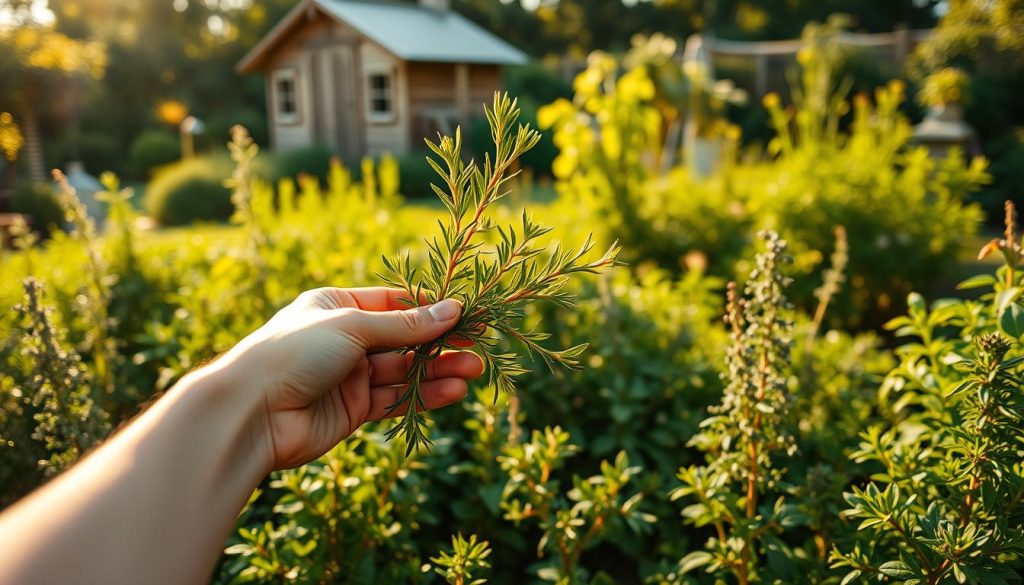
Harvesting herbs right is about timing and technique. It’s all about getting the most flavor and nutrients.
Signs of Herb Readiness
- Robust leaf growth with vibrant color
- No flowering or minimal flower buds
- Leaves at peak size but before woody texture develops
- Morning harvest after dew has dried
Best Harvesting Practices
For the best results, use clean, sharp pruning shears. Cut stems just above a leaf intersection. This helps the plant grow fuller and prevents damage.
- Use sanitized cutting tools
- Cut in the morning for maximum flavor
- Remove no more than 1/3 of the plant at once
- Harvest before plants begin to flower
Storing Fresh Herbs
Proper storage keeps your herbs fresh and flavorful. Wrap them in damp paper towels and store in sealed bags in the fridge. You can also freeze or dry them for longer use.
- Refrigeration: Up to one week
- Freezing: Several months
- Drying: Up to one year
Common Mistakes in Herb Gardening
Starting with seasonal herb gardening can be challenging. Many beginners make mistakes that harm their herb garden. Knowing these errors is key to growing herbs well.
Overwatering: A Silent Herb Killer
One big mistake is overwatering. Herbs like well-drained soil and not too much water. Too much water can cause:
- Root rot
- Fungal growth
- Nutrient deficiencies
- Weakened plant structure
Pest Control Pitfalls
Not taking pest control seriously is another mistake. Herbs attract pests that can harm your plants. To control pests, you need:
- Regular garden checks
- Natural ways to keep pests away
- Quickly spotting pest problems
- Using prevention methods
Seasonal Adaptation Challenges
Ignoring seasonal changes can ruin your herb garden. Each season has its own needs for growing herbs. Gardeners who succeed adapt to these changes, keeping their herbs safe from extreme weather and light.
By knowing and avoiding these mistakes, you can create a lush, productive herb garden. It will give you fresh, tasty herbs all year.
Companion Planting with Herbs
Seasonal herb planting gets better with companion planting. This method makes herbs grow better by pairing them with other plants. These pairs help each other grow well.
Best Companion Plants for Herbs
Companion planting changes how you garden with herbs. Some great pairs include:
- Basil is great with tomatoes, keeping pests away
- Rosemary goes well with sage and thyme
- Chives keep aphids off roses
- Parsley helps asparagus grow
Benefits of Companion Planting
Planting herbs smartly has many benefits. Companion plants can make soil better, keep pests away, and use space well. They also cut down on the need for chemicals.
How to Plan Your Garden Layout
When planning your herb garden, follow these tips:
- Put herbs together that need the same water and sunlight
- Use vertical layers with tall and short plants
- Change where you plant herbs each year to avoid soil problems
- Make sure there’s enough space between plants
Using companion planting makes your herb garden stronger and more fruitful.
Cooking with Harvested Herbs
Growing top seasonal herbs for your garden opens up a world of culinary possibilities. Fresh herbs can turn ordinary dishes into extraordinary culinary experiences. They bring vibrant flavors and nutritional benefits right from your garden to your kitchen.
The best herbs to plant seasonally offer unique taste profiles that can elevate any meal. Knowing how to use and preserve these herbs will help you enjoy their flavors all year long.
Flavor Profiles of Popular Herbs
Each herb brings a distinctive taste to your cooking:
- Basil: Sweet and peppery, perfect for Italian dishes
- Rosemary: Woody and pine-like, great for roasted meats
- Thyme: Earthy and slightly minty, excellent in soups
- Cilantro: Bright and citrusy, ideal for Mexican cuisine
Recipes Featuring Fresh Herbs
Try out simple recipes that highlight your garden’s herbs:
- Herb-infused olive oil
- Fresh pesto sauce
- Herb butter spreads
- Garden salad with mixed herb dressing
Preserving Herbs for Winter Use
Preserve your herb harvest with these methods:
- Drying herbs in bunches
- Freezing in olive oil
- Creating herb-infused vinegars
- Making herb salt blends
By mastering these techniques, you’ll enjoy the flavors of your seasonal herb garden all year.
Growing Herbs Indoors
Seasonal herb planting doesn’t stop when cold weather arrives. Indoor herb gardening is a great way to keep fresh herbs all year. Winter is a great time to start an indoor herb garden in your kitchen. It adds both flavor and greenery to your home.
Choosing the Right Containers
Choosing the right containers is key for indoor herb gardening. Your guide should focus on containers with good drainage and enough room for roots. Here are some good options:
- Ceramic pots with drainage holes
- Terra cotta planters
- Recycled containers with added drainage
- Specialized herb growing kits
Indoor Light Sources for Herbs
Herbs need enough light to grow well indoors. Most herbs need 6-8 hours of bright light each day. If sunlight is scarce, try these alternatives:
- South-facing windows
- LED grow lights
- Fluorescent light panels
- Rotating plant locations for maximum light exposure
Care and Maintenance for Indoor Herbs
Proper care keeps your indoor herb garden healthy and productive. Watch how much you water, keep an eye on the temperature, and prune when needed. Herbs like basil, chives, and mint do well indoors in winter.
Remember, each herb is different. Regular checks and gentle care will make your indoor garden thrive. It will give you fresh flavors even in the coldest months.
DIY Herb Garden Ideas
Creating a seasonal herb garden doesn’t need a big outdoor area. With creative DIY projects, even small spaces can become green oases. Being creative is key when planning your herb garden.
Vertical Garden Options
Vertical gardening is perfect for those with little space. Here are some seasonal herb planting tips for vertical gardens:
- Repurpose wooden pallets as hanging herb walls
- Install wall-mounted planters on sunny exterior surfaces
- Create tiered shelving units for multiple herb levels
Container Gardening Solutions
Container gardening lets you grow herbs in flexible ways. Turn everyday items into unique planters to make the most of your space. Think about using:
- Mason jars for small herb collections
- Recycled tin cans with drainage holes
- Vintage colanders for quirky herb displays
Herb Spiral Designs
Herb spirals are a creative way to plant herbs. This design creates different growing areas for various herbs in a small space. Made from stones or bricks, they ensure good drainage and make the most of the space.
Using these DIY ideas can turn small areas into productive gardens. With some planning and creativity, anyone can grow a successful herb garden, no matter the size of their space.
Seasonal Herb Planting Resources
Learning about seasonal herb planting needs good resources. Whether you’re new or have experience, the right guide can change how you grow herbs. This part talks about useful resources for your herb gardening journey.
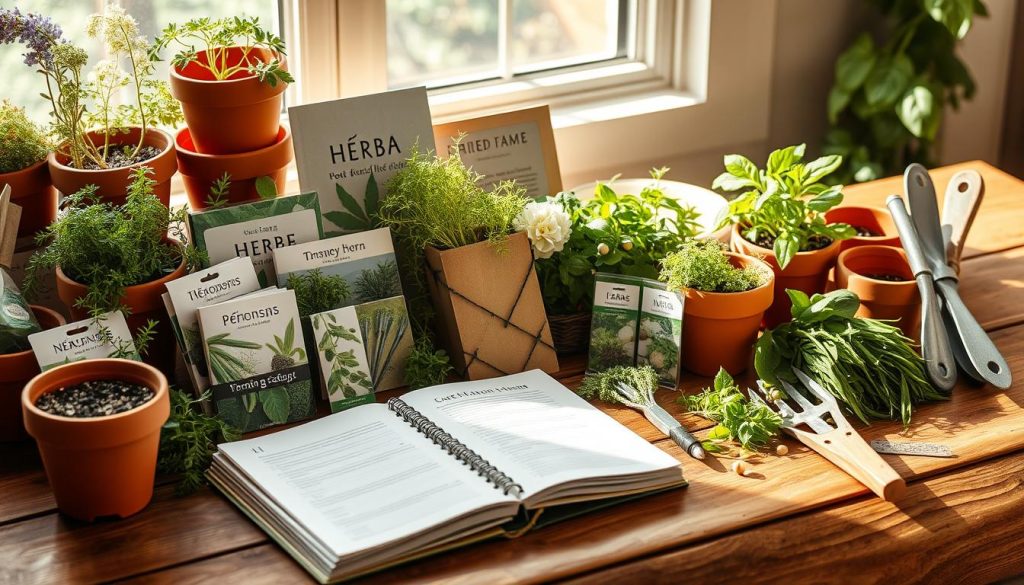
Recommended Books and Guides
Start your journey into seasonal herb planting with these top picks:
- The Herb Gardener’s Essential Guide by Barbara Pleasant
- Rodale’s Basic Organic Gardening by Deborah L. Martin
- The Complete Herbs Sourcebook by David Hoffmann
Online Gardening Communities
Join online groups to meet other herb lovers:
- Reddit’s r/herbgardening subreddit
- Garden.org community forums
- Facebook Herb Gardening Groups
- Pinterest herb gardening boards
Local Extension Services for Assistance
Local extension services give advice for your area. They offer:
- Free gardening workshops
- Soil testing services
- Expert consultations
- Regional planting calendars
Using these resources can help you grow better herbs. You can make a garden that fits your local climate.
Organic Herb Gardening Practices
Organic herb gardening is a green way to grow tasty and healthy herbs in your backyard. It follows natural methods that keep plants and the environment safe.
Choosing organic gardening has many perks for herb lovers. It lets gardeners grow amazing herb gardens without using harmful chemicals.
Exploring the Benefits of Organic Growing
- Produces healthier, chemical-free herbs
- Protects local ecosystem and beneficial insects
- Improves soil quality naturally
- Reduces environmental impact
Natural Fertilizers for Herb Gardens
Choosing the right organic fertilizers can make your herb garden better. Here are some good choices:
- Compost
- Worm castings
- Bone meal
- Fish emulsion
Sustainable Soil Management
Keeping soil healthy needs a complete plan. Use crop rotation, cover crops, and avoid tilling. These steps help your garden stay productive over time.
Experts say to test your soil’s pH and add organic stuff like Scotts Performance Naturals™ Soil Improver. This makes a great place for your herbs to grow.
Incorporating Herbs Into Your Landscape
Creating a beautiful garden is more than just planting. Seasonal herb planting turns your outdoor space into a lively, useful area. It pleases both garden lovers and nature fans.
To plan a seasonal herb garden, think about where and how to design it. Herbs can do many things in your garden. They can help grow food, look good, and even help the environment.
Creative Herb Landscaping Ideas
- Integrate culinary herbs between flowering plants
- Create mixed border gardens with herb varieties
- Design herb spiral gardens for visual interest
- Use herbs as ground cover in challenging terrain
Attracting Pollinators with Herbs
Some herbs are great at attracting pollinators. Bee balm, lavender, and oregano can make your garden buzz. They offer food and safe places for helpful insects.
Herbs as Decorative Borders
Seasonal herb planting lets you make beautiful garden borders. Thyme, rosemary, and sage have nice leaves and can be used in cooking. They’re great for lining paths or setting off garden areas.
- Soft herbs like chamomile create gentle, flowing borders
- Woody herbs provide structured, architectural elements
- Mixed herb borders offer year-round visual appeal
The Future of Seasonal Herb Gardening
Seasonal herb planting is changing fast, with new ideas making gardening easier. People living in cities and suburbs are finding creative ways to grow herbs in small spaces. This makes gardening more accessible than ever.
Now, gardeners are using water-saving methods like drip irrigation and collecting rainwater. They’re also using vertical gardens and compact systems. This lets apartment and small home dwellers grow herbs, even without a big garden.
Technology is also changing herb gardening. Smart indoor systems with automated lights and temperature control are helping gardeners grow herbs all year. Community herb gardens are popping up, bringing people together to grow food sustainably.
The future of herb gardening looks bright. Trends are moving towards more biodiversity, being kind to the environment, and new growing methods. Gardeners will have access to better tools and creative ways to use herbs in their daily lives. This makes herb gardening an exciting and evolving field.
